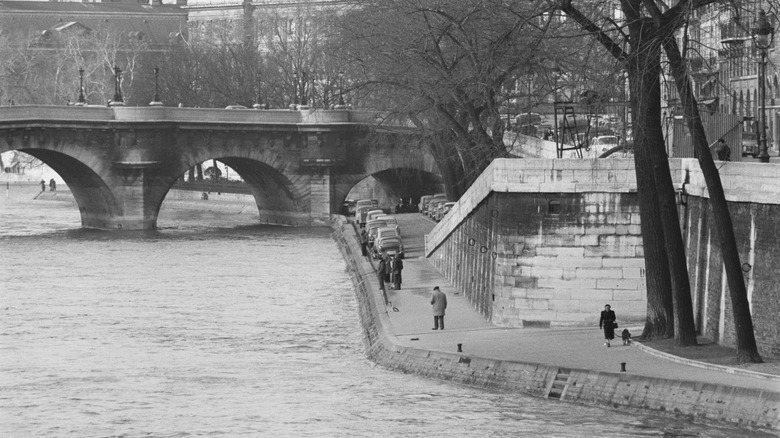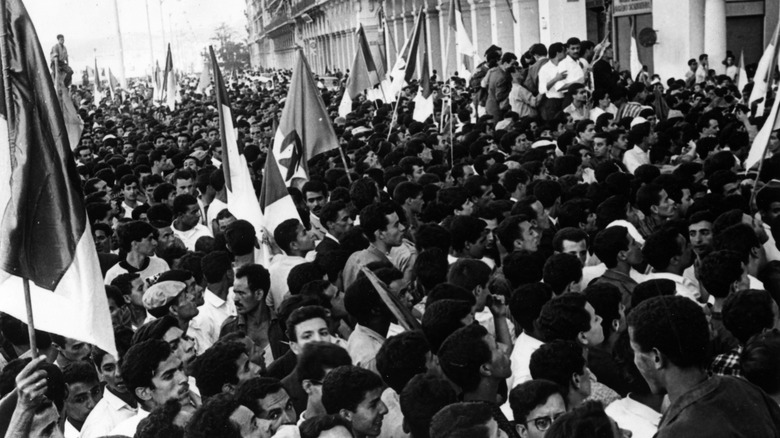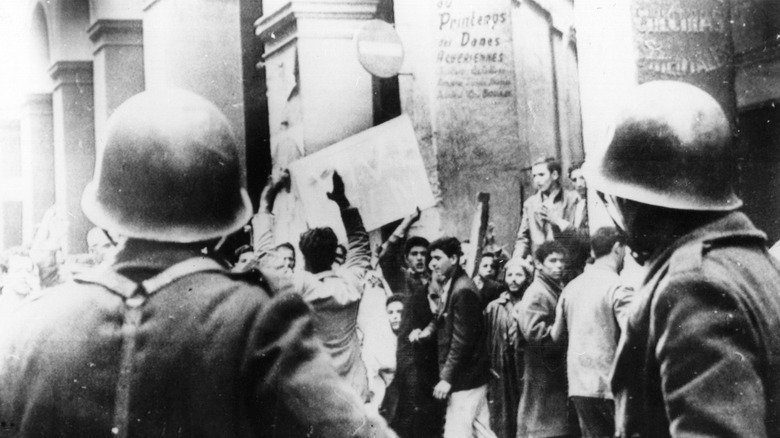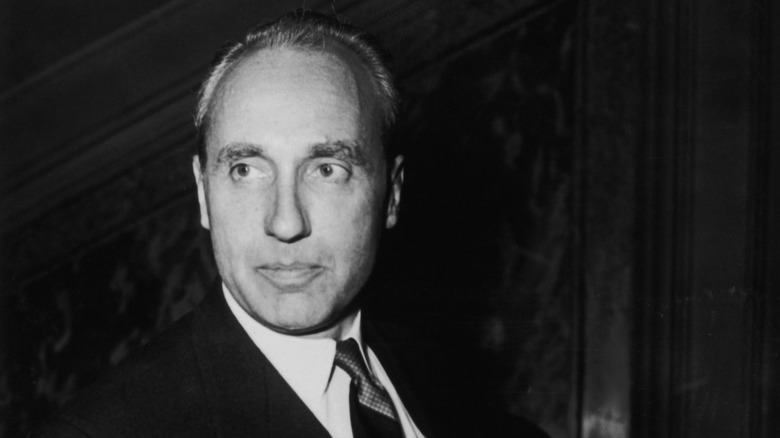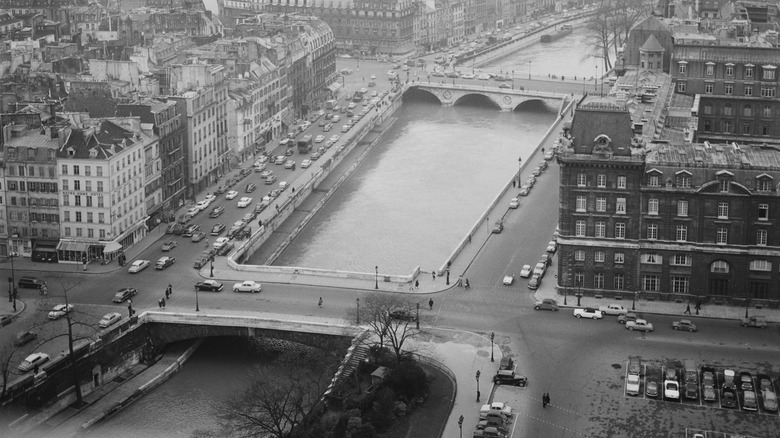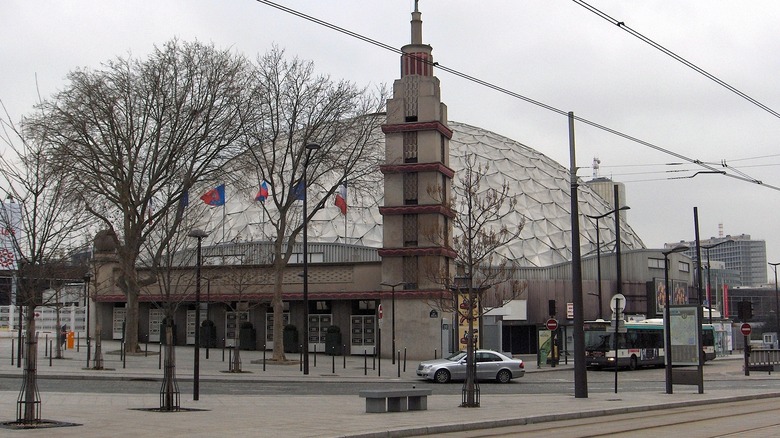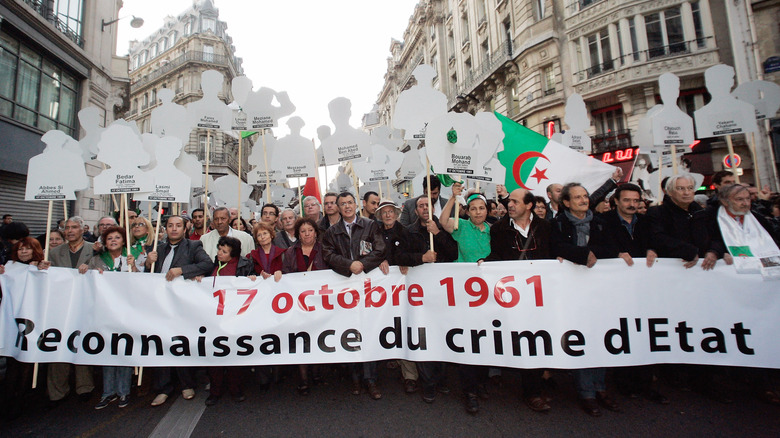What Really Happened In The 1961 Paris Massacre?
In the days following the October 17, 1961 massacre in Paris, France, the riverbanks of the Seine were briefly covered with the words "Ici on noie les Algériens," meaning "Here we drown Algerians," per "Absent the Archive." But the graffiti was quickly painted over as the French authorities sought to suppress knowledge of the massacre. People of North African descent in Paris were targeted and killed by French police before and after the October 17 massacre, but the day of the FLN-organized demonstration protesting a racist curfew was one of the bloodiest repressions of them all. And while French police targeted people of Algerian descent, those of Moroccan and Tunisian ancestry were also swept up in the crackdown.
As of 2021, the French state has never addressed its responsibility for the massacre, and as the archives remain partially sealed, the extent of the slaughter remains unknown. The "official report" that spread after the mass murders insisted that police fired in self-defense, but there's no evidence to support this claim. Meanwhile, the evidence of a peaceful demonstration turning into a pogrom is overwhelming, despite all the attempts at suppression. Here's what really happened in the 1961 Paris massacre.
The war for Algerian independence
From 1954 to 1962, the Algerian Front de Libération Nationale (FLN) successfully fought French forces for independence after being subjugated as a colony for over 100 years. The uprising began with small-scale coordinated attacks on French military posts, and the French military retaliated by "raking over" villages and towns and inciting terror through torture, arrests, and bombings, according to Tufts University. The French government knew about the use of torture, executions, and forced displacements against Algerians, Al Jazeera reports. It was only in March 2021 that President Emmanuel Macron of France admitted that French soldiers were responsible for murdering Algerian revolutionary Ali Boumendjel after claiming that he'd died by suicide in 1957. Meanwhile, the FLN initially only targeted the French military, but as the war continued, there were increasingly more retributive attacks against civilians.
It's estimated that between 350,000 to 1.5 million Algerians lost their lives during the war for independence, while French military and European civilian casualties due to the war number around 15,000, according to a report in the IOSR Journal Of Humanities And Social Science. For four years, the FLN fought the French in Algeria, but in autumn 1958, the FLN brought the fight for independence to mainland France. As Edward Said notes in "Culture and Imperialism," the FLN called mainland France the "seventh wilaya," including it with the six wilayas that Algeria was divided into. In doing so, "the contest over decolonization [was moved] from the peripheries to the center."
FLN vs. the French police
As the Front de Libération Nationale moved the battle for independence into Paris, France, they started assassinating French military personnel and police. The Funambulist writes that Algerians who were considered to be "traitors" were also targeted for assassination. As French police officers demonstrated on March 13, 1958, to demand "more latitude and immunity," Maurice Papon was made prefect of the Seine the following day and was put in charge of eradicating the FLN in Paris. According to "Europe After Empire" by Elizabeth Buettner, Papon was known for being general secretary of the Bordeaux police during the Second World War and had been responsible for the deportation of over 1,600 Jewish people to German concentration camps.
By the end of August 1958, up to 5,000 Algerians were rounded up by the police and held in three detention facilities, one of which held up to 13,000 Jewish people on July 17, 1948, before deporting them to Auschwitz. Verso Books writes that the raids took place in the early morning and late at night as Algerian people were pulled from their beds. At the interrogation and detention centers, they were subjected to "drawn-out and sadistic rituals of racial abuse." French police forces would also destroy the shelters of North African people with crowbars and sledgehammers.
Protesting a racist curfew
On October 5, 1961, a curfew was imposed in Paris. However, the curfew didn't apply to everyone and instead singled out "French Muslims of Algeria," per France24. In response, the FLN organized demonstrations in Paris for October 17. According to the Los Angeles Review of Books, the timing of this curfew was deliberate since a ceasefire was in effect. In fact, some historians believe that Maurice Papon exploited the ceasefire "to rachet up the pressure on the nationalists."
According to The Funambulist, the protest was peaceful from the beginning and was composed of Algerians, Moroccans, and Tunisians, and everyone was told to participate in the demonstrations unarmed or risk severe punishment by the FLN. And on October 17, between 20,000 and 30,000 people took to the streets of Paris. But the French police had learned of the demonstrations in advance, and Papon made a plan to disrupt it. Several routes had been planned for the march, and up to 2,000 police were posted at key locations, including exit ways and metro stations. The police were also heavily armed with batons, rifles, and submachine guns.
Police massacre hundreds
As Algerian, Moroccan, and Tunisian demonstrators reached the policemen, they were met with unquenchable violence. While it's not believed that Maurice Papon gave a direct order to incite a massacre, The Funambulist notes that during the "bloodbath of Saint-Michel," Papon was only meters away in his police command room. And even without an explicitly direct order, Papon had still given his officers free rein, so there was little surprise when "unprovoked, the police fired into crowds, and bludgeoned with impunity," according to "Absent the Archive" by Lia Brozgal.
It's unclear exactly how many people were murdered by the police during the October 17 massacre, but it's estimated that up to 300 people were detained or killed, and up to 84 were murdered in the River Seine. Some were thrown into the river already dead, while others were thrown in alive with their hands and feet bound. Meanwhile, police referred to these victims as "drowned by bullets." France24 reports that after the massacre, bodies washed up for days. According to Qantara, the French state tried to suppress news about the extent of the violence for years and initially reported that only three protestors were killed.
Over 11,000 arrested
In addition to the hundreds who lost their lives at the hands of the French police, over 11,000 Algerians, Moroccans, and Tunisians were arrested on October 17, 1961. France24 reports that after being arrested, the demonstrators were held in buses — which were normally used by the state-owned public transport network — and were taken to stadiums that were turned into detention centers.
According to "On the Edges of Development," police kept the thousands that they'd arrested at the Palais des Sports, where they were tortured for several days. But before long, they were moved to an internment camp at Vincennes because the Palais des Sports had to be "disinfected" by October 20 for a Ray Charles concert. After days of killing and arrests, police sought to suppress the official record, and documentary evidence of the October 17 massacre was seized. President Charles de Gualle reportedly called the massacre "unacceptable, but secondary," Lia Brozgal writes in "Absent the Archive."
The legacy of the massacre
Knowledge of the October 17 massacre was largely suppressed by the French authorities and administration, and even as of 2021, the police archives remain partially closed. According to News Azi, it wasn't until the late 1980s when two conservators — Brigitte Lainé and Philippe Grand — discovered the prosecution's register from the time of the massacre that primary evidence of the tragedy was discovered. But even at that point, they didn't draw attention to the documents they discovered out of concern that they'd be destroyed or hidden.
When Jean-Luc Einaudi published "La Bataille de Paris: Octobre 17, 1961" in 1991, it was the first investigation into the massacre, according to France24. And when Maurice Papon was tried for crimes against humanity, Einaudi called Grand to testify. But after his testimony, Grand was punished and told News Azi in an interview that he was barred by the administration "from the archival sites where [he] was working, the prisons' archives and from the courthouse."
In October 2021, President Emmanuel Macron acknowledged the massacre, calling it "brutal, violent, bloody," and "inexcusable." While he attended a commemoration event, he neither gave a public speech nor issued a formal apology. Algerian journalist Maher Mezahi described it as a "half-step" and noted that Macron "has never recognized the state's responsibility in the massacre," Al Jazeera reports.
